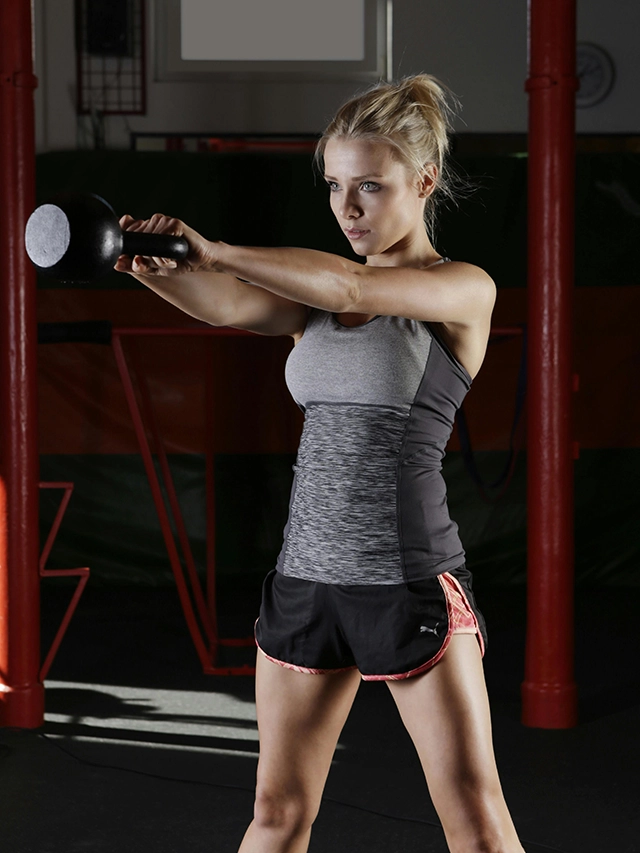Last Updated on February 16, 2025
A 3-day workout split sounds like the perfect timeframe for beginners. Are you one of those people who is hesitant about taking the first step in their fitness journey and starting to work out? Many people struggle with this issue simply because they have no idea what to do in the gym, and designing a good workout program to follow just seems too frustrating and hard.
If that sounds like you, then stick around because I’m going to help guide you through it all. A 3-day workout split can be a great way to structure your routine. Make sure you keep track of your 3-day workout split with these fitness apps so you know how much progress you are making. Using a 3-day workout split helps you stay consistent and focused on your fitness goals.
So What Is the Perfect Workout Split?

Today’s topic of discussion is the best 3-day workout split you can do for optimal results. To start things off, what do we mean by a 3-day workout split? It’s a workout routine where you categorize muscle groups and train each group on a different day of the week. A 3-day workout split means you’ll only be working out for three days, which is great if you’re short on time and don’t want to be in the gym five times a week. This type of 3-day workout split is especially effective for beginners since it allows plenty of rest time between workouts, facilitating proper recovery and strength and muscle gains.
Now you might be wondering how you should structure your 3-day workout split for maximum efficiency. You have a few options, such as the push/pull/legs 3-day workout split, which I’ll be talking about extensively in a bit, and upper/lower 3-day workout splits for three full-body workouts.
The Push/Pull/Legs Split

Push/pull/legs are probably the most common and popular 3-day workout split out there and for a good reason too – it just works! Let’s break down the science behind this split. What do we mean by push/pull/legs, and why do we group muscles?
The push muscles are the pectoral muscles (the chest), the deltoids (shoulders), and the triceps. These three muscles are usually grouped because any pressing (pushing) movement will work all three muscles (except for isolation exercises of course). The exercise at hand will determine which muscle is being prioritized. For example, when we bench press, our pectoral muscles are the primary muscles working, while the anterior shoulder and triceps are working secondarily. So it only makes sense to group these muscles.
The pull muscles refer to the Back and Biceps, which include the traps (upper, middle, lower), the lats (latissimus dorsi), rhomboids, erector muscles of the low back, the biceps brachii (two heads of the biceps), and the brachialis.
Last but not least is day three for legs. For the sake of simplicity and not mentioning all the muscles of the lower body, we’ll just group them as Quads short for Quadriceps, the hamstrings, glutes, and calves. The lower body is grouped alone because it’s probably the most challenging workout of the week and the most fatiguing.
Here’s what a sample workout might look like:
The 3-Day Workout Split
Day 1: Push Day
- Flat barbell bench press (3 sets of 10-12 reps)
- Incline dumbbell press (3 sets of 10-12 reps)
- Pec deck chest flies (3 sets of 10-12 reps)
- Shoulder lateral raises (3 sets of 10-12 reps)
- Reverse pec deck for rear delts (3 sets of 10-12 reps)
- Triceps rope pushdowns (3 sets of 10-12 reps)
- Skullcrushers (3 sets of 10-12 reps)
Suggested Equipment:




Day 2: Rest
Day 3: Legs
- Barbell squats (3 sets of 8-10 reps)
- DB alternating lunges (3 sets of 10 reps/leg)
- Stiff-legged deadlifts ( 3 sets of 8-10 reps)
- Leg extensions (3 sets of 12-15 reps)
- Leg curls (3 sets of 12-15 reps)
- Seated calf raises (3 sets till failure)
- Standing calf raises (3 sets till failure)
Suggested Equipment:




Day 4: Rest
Day 5: Pull day
- Bent over barbell rows (3 sets of 10-12)
- Wide grip lat pulldowns (3 sets of 10-12)
- Seated cable rows (3 sets of 10-12 reps)
- Cable pullovers (3 sets of 10-12)
- Dumbbell Shrugs (3 sets of 12-15 reps)
- Preacher curls (3 sets of 10-12 reps)
- EZ-bar close grip curls (3 sets of 10-12 reps)
Suggested Equipment:





Day 6: Rest
Day 7: Rest
If you’re wondering about abs/core training, you can train abs at the end of each workout or even on your rest days in the comfort of your own home. It’s worth mentioning that when performing compound lifts, such as squats, deadlifts, or bent-over rows, you should always brace and engage your core muscles so they’ll already be working during your weight-lifting session.
Here’s a sample core workout you can follow:
- Planks (start by holding the static position for 30 seconds)
- Side planks (20-30 seconds per side)
- Leg raises (10-15 reps)
- Tuck-ins (10-15 reps)
- Crunches (10-15 reps)
- Cable woodchopper (10 reps/side)
- Dead bug (10 reps/side)
When it comes to abs, you can train them in a circuit fashion, meaning you perform one exercise and immediately move to another, and so on until the whole lot is complete. Better yet, if you feel up to it, you can repeat the circuit a second time. Another alternative is the conventional way – finish the number of desired sets for an exercise and then move on to the next.
Important Notes:
Remember not to neglect your warm-up. It may not be the most fun part of training, but it’s crucial for performance and injury prevention. I would recommend a 5-10 min cardiovascular warm-up on either a treadmill or elliptical in order to get the heart pumping and increase muscle temperature. Follow this with some dynamic warm-ups to prep the joints for the upcoming weights. On your push and pull days, I’d advise you to warm up your rotator cuff muscles by performing external/internal rotations in different planes of motion. You can either use a band or cable to improve shoulder stability while performing any pressing or overhead movements.
As for lower body days, try some dynamic stretching before the workout and some mobility drills and glute and core activation if necessary.
The sets and reps mentioned above are going to be your working sets, so you should also perform 1-2 warm-up sets with a lighter weight to prepare your body for the heavier sets to come. This will also help you perfect your technique and execution.
As you may have noticed, I did not specify the intensity of the exercises, i.e. the weight, because it’s strictly specific to the individual. Pick a weight where you’re able to complete the desired reps and sets, and the last 1-2 reps should be a bit challenging. This shouldn’t be to the extent where you’re fully depleted and can’t perform another set. It might take you a session or two to assess your strength and find the optimal training intensity for you.
As for rest time, if you’re training for hypertrophy (building muscle), 90 seconds should be enough rest in between sets. If you’re going heavy, rest for up to 3 minutes.
After a while, the sets and reps and even the weights will become easier, which tells us it’s time to add another set or increase the weight, also known as progressive overload.
Don’t Skip Cardio

Last but not least, I would strongly recommend doing any kind of cardiovascular work either at the end of your workout or on the non-workout day for at least 30 minutes. It can even be something as simple as going for a walk. At the end of the day, you wouldn’t want to neglect the most important muscle of all, the heart.
To Sum Up
The 3-day workout split is perfect for beginners, as it allows for plenty of rest time between workouts. Resting is essential for proper recovery and strength and muscle gains, and the 3-day workout split provides an excellent balance between training and recovery.
So follow our 3-day workout split program carefully for optimal results. Make sure you listen to your body when it needs rest and do not neglect your warm-up or stretching exercises. Most importantly, the 3-day workout split also leaves room for incorporating cardio sessions without overtraining.
Women’s Fitness Workouts | Legs, Abs and Cardio Exercise
2-Week Christmas Workout With Tips To Help You Bring In The New Year
3 Female Fitness Motivation Tips: New Season, New You
5 Gym Essentials for Beginners: Ignite Your Fitness Journey with What to Do and Bring to the Gym
Are 3-day workout splits effective?
Absolutely! Because it enables you to maximize both the intensity of your workouts and your recovery, a three-day split is beneficial for developing muscle. Possibly the most crucial factor in developing muscle is recovery. No matter how hard you exercise in the gym, you won’t get the results you want if you don’t give yourself enough time to recover.
How should I split my workouts 3 days a week?
A three-day split involves working your upper body in a push/pull program over two days and your lower body on a different day. A typical three-day split would consist of push exercises for the chest and triceps on Day 1, pull exercises for the back and biceps on Day 2, and leg exercises on Day 3.
Can you bulk on a 3-day Split?
A three-day split involves working your upper body in a push/pull program over two days and your lower body on a different day. A typical three-day split would consist of push exercises for the chest and triceps on Day 1, pull exercises for the back and biceps on Day 2, and leg exercises on Day 3.
Andre is a strength and conditioning coach/personal trainer with over 9 years of experience in the field. His methodology is "Assess. Correct. Train".
- Andre Koumachianhttps://successiblelife.com/author/andre-koumachian-certified-personal-trainer/
- Andre Koumachianhttps://successiblelife.com/author/andre-koumachian-certified-personal-trainer/
- Andre Koumachianhttps://successiblelife.com/author/andre-koumachian-certified-personal-trainer/
- Andre Koumachianhttps://successiblelife.com/author/andre-koumachian-certified-personal-trainer/





